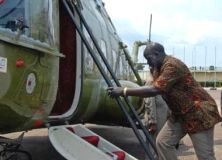Details emerge about Garang crash
Oct 25, 2005 (NAIROBI) — Two months after the tragic death of Sudanese Vice-President Dr John Garang following a helicopter crash, details are beginning to emerge how the aircraft plunged into the Kidepo Valley.
 Although the Russian company that manufactured the ill-fated helicopter has written a letter to the Sudanese government denying any blame in the fatal crash on July 30, 2005, new theories suggest that the aircraft may have experienced navigational problems.
Although the Russian company that manufactured the ill-fated helicopter has written a letter to the Sudanese government denying any blame in the fatal crash on July 30, 2005, new theories suggest that the aircraft may have experienced navigational problems.
Kazan Helicopters, who manufactured the aircraft, back their letter with acceptance certificates signed by Ugandan engineers who confirm that the helicopter had been repaired and declared air worthy.
This may clear the Russians but throw the problem squarely on the doorstep of the Ugandan authorities who owned and maintained the aircraft.
A new theory indicates that the Ugandan engineers who inspected the helicopter may not have been adequately equipped to maintain the aircraft even though they were trained in Russia.
Investigators from the United States, Sudan and Kenya were invited by Ugandan President Yoweri Museveni to work with detectives from his country to shed some light into the crash.
According to the Russian company, the helicopter had only covered 20 hours since it underwent repairs and an overhaul.
However, the investigations committee is yet to come up with an interim report and the Kenyan representative in this committee, Peter Wakahia, said that it was too early to expect this dossier. The engineer leading the technical staff in the crash investigation says the final report is very far from complete.
The Kenyan investigator, however, declined to make any comments regarding the matter and referred all queries to Uganda’s director of civil aviation, Ambrose Akadonda, who is co-ordinating the probe team.
The helicopter carrying Dr Garang and his group crashed in the Kidepo Valley in the southern part of Sudan, killing all those on board.
The disappearance of the helicopter from the radar screen caused alarm in Kenya, Uganda and Sudan as efforts were made to trace its whereabouts.
Dr Garang, who had fought in a civil war lasting 21 years against the Arab north, had just served as the country’s vice-president for 20 days following a peace agreement signed in Nairobi in early June.
When the helicopter crashed, there was speculation that there could have been foul play. But this was ruled out by President Museveni, the Sudan People’s Liberation Movement (SPLM) and Garang’s widow Mrs Rebecca Nyandeng.
The manufacturers of the helicopter assert that it had flown for 20 hours after it underwent an overhaul and modernisation in February and July this year.
Before the helicopter crashed, it had been in Uganda for one week after it was flown from Russia.
The letter from the manufacturers seems to lay the blame on Ugandan engineers.
According to sources, the investigative team is likely to concentrate their inquiry on the mechanical condition of the aircraft and, in particular, the altimeter, cockpit voice recorder, flight data recorder and the advance moving maps system.
Last week, the EastAfrican reported that Dr Garang had suggested to the helicopter pilot that he should land at Soroti or Moroto on the eastern part of Uganda.
It is believed that Dr Garang’s suggestion was due to the fact that he suspected that the crew was having problems in navigating the aircraft to its final destination, New Site.
It is also noted that a conversation between Dr Garang’s aide and crew was hampered. This is a pointer that communication in the helicopter was poor and should have been noted by the Ugandan engineers.
A steward on the aircraft was heard on the cockpit voice recorder complaining that the hot water system was not functioning. She was, however, informed by the crew that it had been switched off.
The investigators also note that the flight data recorder, which is the only unit in all aircrafts that is built to survive heat, crashes and intense pressure, was partially damaged.
Investigators will try to confirm if the altimeter (an instrument for measuring altitude) was in good working order. Reports say devices recovered from the Russian helicopter indicated that the aircraft was flying well above ground.
But pictures taken at the site of the crash indicate that the helicopter crashed into a cliff then plunged into the Kidepo Valley 300 metres below.
Aviation experts believe that the aircraft could have been flying blindly at night without the aid of the altimeter before it crashed.
Another crucial navigational aid on the helicopter, which is deemed to have failed, is the Advance Moving Maps System (AMMS).
In an ideal situation, when the altimeter is not working, the AMMS should take over. This system captures the terrain as far as 100 kilometres away.
Had the AMMS been in good working order, the pilot should have been able to see the cliffs long before hitting them, sources suggest.
(The Nation)
